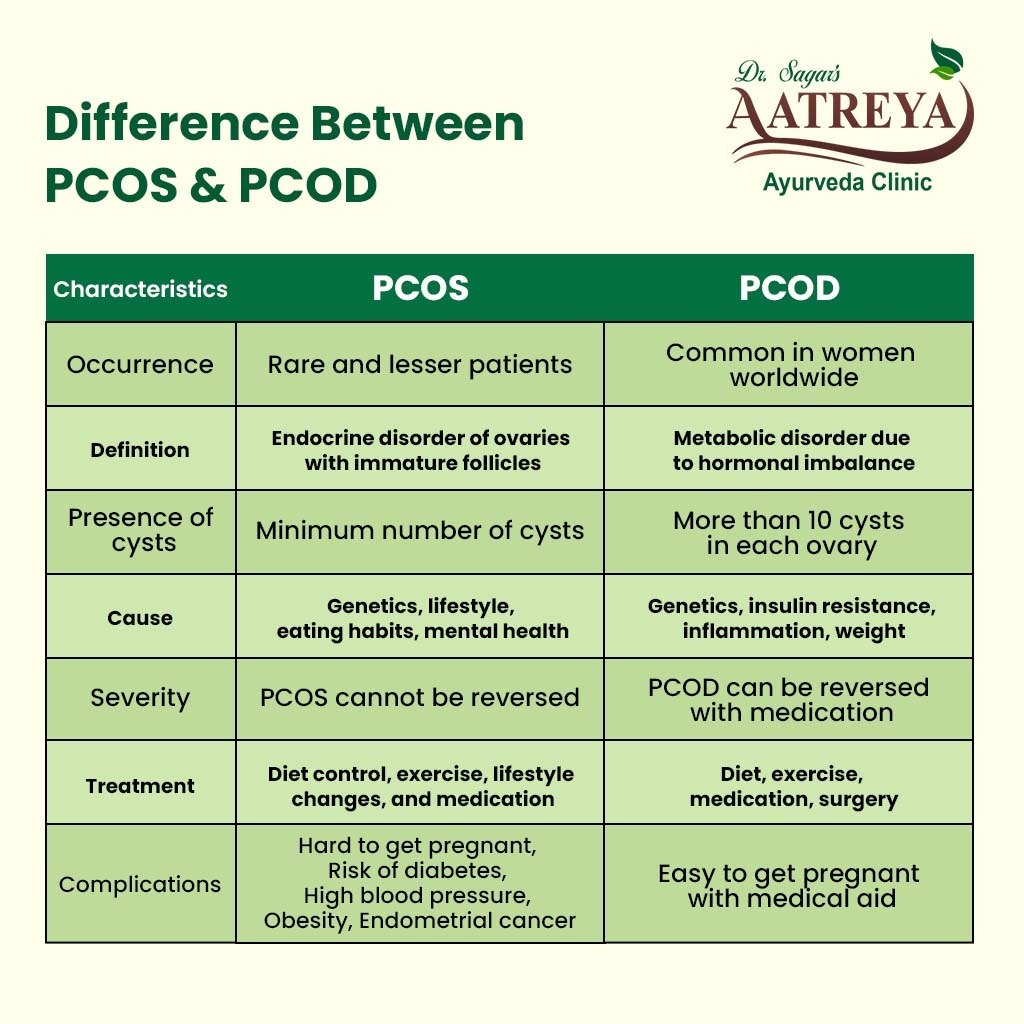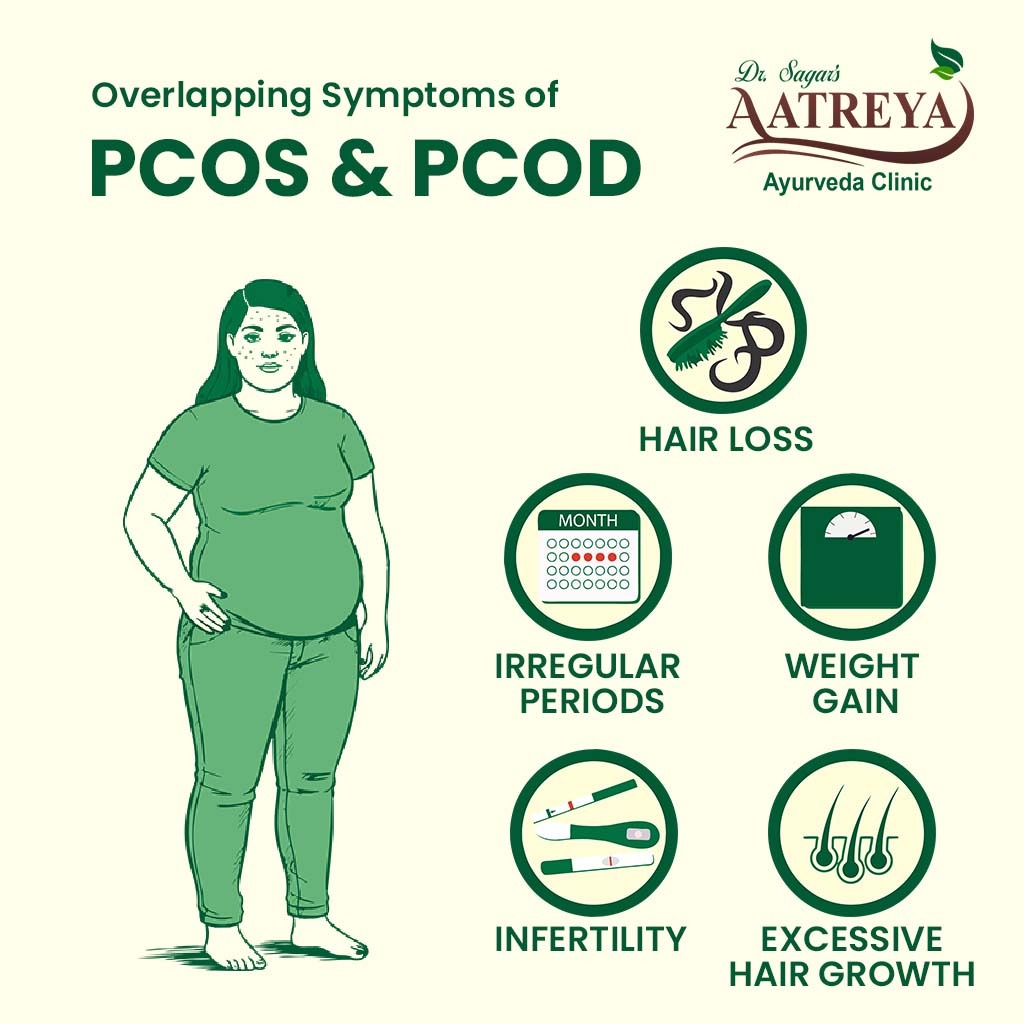What exactly is PCOS ?
PCOS, defined as an endocrine disorder and characterised by a myriad of tangible and intangible symptoms, commonly irregular menstruation, hyperandrogenism ie possession of excessive male hormones, insulin resistance, and multiple cysts on the ovaries, is also one of the leading causes of infertility and weight gain among women of healthy reproductive age.
According to contemporary medical theory, PCOS results from a hormonal imbalance that is either developed or innate, typically accompanied by high androgen levels and insulin resistance. This imbalance can disrupt the ovaries' normal function, resulting in irregular ovulation or, in certain situations, anovulation—the absence of ovulation. Even health-threatening issues like hirsutism, acne, fast weight gain, and metabolic disorders like type 2 diabetes can result from it. Things get much worse when people engage in bad habits like eating a lot of processed foods and sitting around all day.
PCOD and PCOS as terms and diagnoses are often used interchangeably, but there exists an important distinction between the two. PCOS, as mentioned, is a more comprehensive disorder that also encompasses hormonal imbalances and endocrine disorders. PCOD is a more generally spread concern and manifests itself mainly in the way of cysts on the ovaries. It is milder than PCOS and usually results in irregular periods and bleeding. Unlike PCOS, PCOD can be managed by lifestyle betterment and usually does not result in long-term complications or reproductive issues.
PCOS According to Ayurveda :
In Ayurveda, PCOS is associated with disorders such as Pushpaghni Jatiharini, Artava Kshaya, and Yonivyapad. Like all Ayurvedic science and practice, PCOS too is attributed to the imbalance of doshas in the woman’s body. For instance, a vitiated Kapha Dosha ceases Apana Vata from flowing naturally, which messes up a healthy menstrual cycle. In the same way, an aggravated Pitta dosha and even the Meda Dhatu, which is fat tissue, make the condition worse, causing symptoms like obesity, too much hair growth, and irregular periods.
Acharya Kashyapa described the Pushpaghni Jatiharini, which involves anovulation, obesity, and hyperandrogenism, to bear a striking resemblance to PCOS. Consequently, addressing these imbalances allows Ayurveda to restore the natural functioning of the reproductive system and the entire body.
PCOD and PCOS – What makes them different in Ayurveda ?
While Ayurveda treats them both with a similar approach, PCOS and PCOD are different in their characteristics. Ayurveda does not have the exact concepts of PCOS and PCOD as mentioned today, but there are concepts mentioned in texts that bear a likeness to the same. Some of these are:
- Yonivyapad: While this is not exactly PCOS or PCOD, the concerns fall under this term in Ayurveda, since it describes various disorders that can be seen in the female reproductive system.
- Artava Dushti: Another factor that Ayurveda looks at is this, which is the imbalance or vitiation of the menstrual and reproductive tissue, and indicates an underlying issue with the quality and flow of the menstrual discharge.
- Agnimandya: Literally translated to mean weakened digestive fire, this is a fundamental cause for various health concerns in Ayurveda. It is often referred to in the case of PCOS or PCOD.
- Artavavaha Srotas Dushti: In PCOS and PCOD, the reproductive channels are blocked. These blockages, which impair the flow of nutrients within the reproductive system, are referred to as Artavavaha Srotas Dushti, an important part to heal in the curative process.
- Srotorodha: As PCOS and PCOD are manifested by channel blockage, another important concept to take into account is Srotorodha. This deals with blockages of tissues and bodily channels and how to clear them.

It is important to note that PCOS is a stronger, deeper manifestation of the hormonal imbalance, whose aggravated doshas are dialed to an extreme as compared to those in the case of PCOD. There are a few differentiating factors between the two.
- Doshic Imbalance: PCOD is usually caused by the aggravation of the Kapha dosha, whose qualities of being hairy, sticky, and obstructive lead to the formation of cysts and the blockage of the movement of bodily fluids naturally. PCOS is also a result of a vitiated Kapha dosha, but in addition to that, it also includes an aggravated Pitta dosha and an imbalance of Apana Vata, which governs the cycle of menstruation.
- Dhatu Imbalance: For PCOD, the dhatus of the tissues are impaired in the context of fat, blood flow, plasma, and menstrual fluid. But in this case, the damage does not run too deep and is curable by lighter therapies. For someone suffering from PCOS, this dhatu dushti leads to paired imbalances of various tissues, at a much deeper and profound level, making for more severe symptoms and effects.
- Srotordha: The channels that carry the menstrual fluid are often blocked or obstructed in both cases; however, the severity of the same is much higher in the case of PCOS.
- Treatments: PCOD is curable through the way of dietary and lifestyle modifications such as a simpler and more digestible diet, proper sleep schedules, consistent physical activity, and a less stressful lifestyle, in addition to a few slightly lighter Ayurvedic therapies like Virechana. PCOD, on the other hand, in addition to all this, requires slightly more intensive and stronger procedures such as Basti, Vamana, etc., for a longer duration to be fully cured.
- Infertility: Both conditions can cause infertility, but PCOS has a significantly higher risk of causing chronic infertility if it is not tracked down and treated.
PCOD and PCOS have similar symptoms and causes, but their impact, treatment, and severity differ. Ayurvedic texts have similar, if not the same, concerns and their treatments written down from years ago to help tackle the same.
Ayurveda's presentation of PCOS symptoms :
PCOS is associated with many other diseases. Ayurveda lists out a comprehensive list of symptoms typical of PCOS and in line with what we understand of it now. Some of the most typical and absolute ones are:
- Irregular Menstruation: Refers to Anartava or Artava Kshaya, tardy, light, absent, or even profuse menstruations occurring at unusual times. They are caused by vitiated Vata dosha.
- Obesity: Sthoulya, or Ayurvedic obesity, occurs when the Kapha dosha gets increased and Meda Dhatu gets deposited in the body.
- Acne and Hirsutism: Indications of Kapha and Pitta Dosha imbalance. They increase excess hair and skin issues such as acne.
- Acanthosis Nigricans: Appearance of dark, velvety pigmented skin lesions. They are due to insulin resistance, most commonly associated with worsening of the Kapha dosha.
- Infertility: PCOS can lead to ovulation issues such as Pushpaghni, and hormonal dysregulation that makes pregnancy difficult. Medo Dhatu Vikruti is a name given to metabolic disorders such as insulin resistance as well as lipid derangement.
Ayurveda insists on the interconnection and interdependence of these signs and blames them on internal systemic disturbances. In addressing the cause, it is able to eradicate all the entailed signs as well as annihilate the basal disorder simultaneously. PCOS Treatments.
According to Ayurveda Core Principles of Ayurvedic Treatment for PCOD/PCOS :
Food modification, or Ahara, is the cornerstone of Ayurvedic management of PCOS. Furthermore, the use of some herbal medicines, such as Aushadha, and changing your lifestyle, such as Vihara, is prescribed and suggested. The major objectives of Ayurvedic management are to increase Agni, normalise the Vata, Pitta, and Kapha doshas, and, of course, cleanse the Artava Vaha Srotas, or channels of body reproduction. Let us have a look at this in more detail.
- Guidelines for Foods: One of the rules is not to consume foods that aggravate Kapha dosha, i.e., dairy foods, processed foods, and sweets. The maximum that people can do is consume bitter and astringent foods like methi, bitter gourd, and neem daily. Light and warm food will allow your body to use energy more effectively and digest food better. Consume a lot of water, but not cold or carbonated beverages.
- Changes in lifestyle: Vyayama, or exercise, is said to reverse obesity and insulin resistance. The three best options to get your body back into shape are swimming, fast walking, and yoga. They need to be done every day as a routine called Dinacharya. They need to be done seasonally as a Ritucharya routine. Two other useful interventions to manage cortisol and promote your welfare are stress management and sleep.
Ayurvedic treatments of medicine :
- Kanchnar Guggulu: Balances Kapha and reduces ovarian cysts and is famously known for its scraping effect.
- Ashwagandha: Relaxes tension and balances hormones.
- Shatavari: Delays menopause and results in more frequent menstrual cycles.
- Guduchi: Balances the immune system and allows insulin function.
- Triphala: Keeps the digestive tract healthy and helps with body cleansing.
Panchakarma/Detoxification of PCOD/PCOS :
PCOD and PCOS are well managed by panchakarma, a fundamental practice of Ayurvedic therapy and one of the strongest detoxification methods in the world. Detoxification of toxins and dosha re-establishment are the treatment goals, using the following:
- Basti (Medicated Enema):
- Asthapana Basti: Pushes doshas out of the body
- Anuvasana Basti: Aligns reproductive organs and calms vata.
- Yapana Basti: Especially good for infertility, it is cleansing and nourishing in action.
- Virechana (Purgation): It alleviates hormonal imbalance and purifies the intestines and liver by being counteractive to the Pitta Dosha. It enhances digestion and metabolism as well.
- Uttara Basti: It is a gynaecological treatment where medicine oils are instilled into the vagina to improve follicular well-being and ovulation. It is very effective in cleansing obstructions in the reproductive system.
- Vamana (Emesis): By flushing out Kapha from the upper GI tract, it decreases insulin resistance and facilitates weight loss. The therapy also re-establishes the body's hormone balance.
- Nasya (Nasal Delivery): Not to cure PCOS itself, however, this medication balances hormones through its action on the hypothalamus-pituitary axis, the endocrine system governing reproduction.
Conclusion :
Aatreya Ayurveda is one of the well-renowned clinic for Ayurvedic Treatment For PCOD/PCOS in Pune, Aatreya is trusted destination for authentic healing. Let Dr. Sagar and Dr. Nomina Pampattiwar help you overcome PCOS with Ayurveda’s timeless wisdom. Therefore, to get the best Ayurvedic treatment for PCOS and PCOD and consultation with our Ayurvedic doctor for PCOS and PCOD treatment, contact us at Aatreya at +91 9158563433 and book an appointment and begin the process of eliminating PCOS and its symptoms.
FAQs :
-
Does Ayurveda completely treat PCOS?Ayurveda attempts to manage PCOS by treating its root causes and balancing doshas. Return to normalcy is subject to lifestyle compliance, regularity of treatment, and individual response.
-
How long is an Ayurvedic treatment likely to take to produce results?Dramatic improvements in symptoms like normal menstrual cycles and control of weight take place generally within three to six months. The long-term result requires continued effort and compliance with what is advised.
-
Is Ayurvedic therapy safe to use for everybody?Ayurvedic drugs are safe overall, but must be individualized according to the health profile of each patient by a skilled practitioner. Self-medication is recommended against.
-
Is Panchakarma sufficient to treat PCOS?Panchakarma is a valuable tool, but functions best with diet modification, lifestyle modifications, and herb therapy. It is a cleansing and rejuvenating process.
-
Does yoga assist in controlling PCOS?Yes, yoga can be an effective adjunct therapy because it balances hormones, minimises stress, and improves metabolic health. Bhujangasana, Dhanurasana, and Naukasana postures are particularly helpful.
-
What is the relationship between stress and PCOS?Regular stress upsets the hormonal balance and worsens PCOS symptoms. Pranayama, mindfulness, and meditation are techniques that encourage overall well-being and stress reduction.

